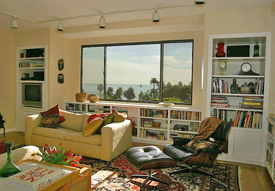Connie Forrest applies psychological tools to the design of interiors and landscape

Constance Forrest’s passion for psychology started with an early curiosity about animal behavior. She trained her own horse as a teenager in Tinton Falls, New Jersey, and realized that riding horses was relational – successful only when animal and rider were operating on the same wavelength.
The experience created “a powerful interest in relationships and the creative things that can happen when a dyad is in attunement,” said Forrest, who received her doctorate from Rutgers’ Graduate School of Applied and Professional Psychology (GSAPP) in 1981.
Creativity is the touchstone of Forrest’s innovative work as a professional in the field of design psychology, an approach that recognizes the powerful role emotions play in people’s reactions to their environment. She and her sister, Susan Painter, who holds a Ph.D. in developmental psychology, head up Forrest Painter Design in Venice, California
The sisters spearheaded this relatively unknown specialty during the late 1990s, their first projects developing interiors for therapists’ offices. Forrest recognized that the “holding environment” for the therapist is literally the physical container of their office, and that it must be designed to support and nurture them and their work.
Forrest uses an original, three-pronged approach with clients, which includes a Place Attachment Inventory (important places clients have lived or visited and associated positive experiences); the Favorite Place, a guided imagery exercise to recall places where clients “felt the best they’ve ever felt”; and the Five Object Inventory, an analysis of objects clients feel so strongly about “they would even call it love.” The object analysis is a kind of projective technique.
“Objects carry powerful associations, and we invest objects with meaning,” Forrest said. “Understanding that meaning gives important information about the person, and clues about the colors, shapes, and materials that will create the emotional experience we intend with our design.”

From her research Forrest forms a design concept for the style of the place (“Japanese boat house in Venice Beach”) and a Design Prescription TM for the emotional experience the space aims to create (“tranquil, harmonious, grounded in spirituality”). The bricks and mortar aspect of the design is built on this base and each project is unique, reflecting the client and the collaboration.
Forrest brings many years of experience as a clinical psychologist, as well as her training in interior and landscape design to her founding work in design psychology. In addition to her work as a principle at Forrest Painter Design, she maintains a private practice in Santa Monica, California. She and Susan Painter designed and taught the first university courses in design psychology at the UCLA program of architecture and interior design.
Connie Forrest trained at GSAPP during the 1970s. “There was no other university-based program like it in the country, because it was a practiced-based degree,” she says. “I’m a hands-on person, and I wanted that experience.”
“Connie and her sister’s field concerns the relationship of all living things with their environment, especially creating supportive, stimulating, or healing environments,” said. GSAPP Dean Stanley Messer. “What a creative use of their psychology background and training.”
This article originally appeared in the Graduate School of Applied and Professional Psychology newsletter, Winter 2012.